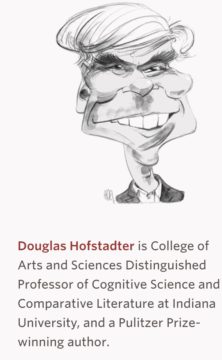Douglas Hofstadter in Inference Review:
 Actually, until 1961, when I was 16, I’d never given any thought to Sweden at all, but everything shifted on a dime when my Dad shared the 1961 Nobel Prize in Physics. That December, our family flew to Stockholm for the ceremonies and it was unforgettable. Not only were the solemn, yet deeply joyous, festivities a once-in-a-lifetime occurrence, but I was powerfully struck by the classic European beauty of Stockholm in the midst of that romantically dark and snowy Scandinavian winter—such a clean and sophisticated city with its old-fashioned trams, its glittering neon signs, its colorful store windows, its elegant ladies and gentlemen, and, last but not least, its strange, alien language.
Actually, until 1961, when I was 16, I’d never given any thought to Sweden at all, but everything shifted on a dime when my Dad shared the 1961 Nobel Prize in Physics. That December, our family flew to Stockholm for the ceremonies and it was unforgettable. Not only were the solemn, yet deeply joyous, festivities a once-in-a-lifetime occurrence, but I was powerfully struck by the classic European beauty of Stockholm in the midst of that romantically dark and snowy Scandinavian winter—such a clean and sophisticated city with its old-fashioned trams, its glittering neon signs, its colorful store windows, its elegant ladies and gentlemen, and, last but not least, its strange, alien language.
When, one day in the Grand Hôtel, which certainly lived up to its name, our family first laid eyes on my Dad’s Nobel diploma, colorfully and exquisitely hand-calligraphed in Swedish, I tried to make some sense of the citation—“För hans banbrytande undersökningar över elektronspridningen mot atomkärnor och därvid gjorda upptäckter rörande nuckleonernas struktur”—but I couldn’t do much with it. Although I knew a weensy bit of German, I didn’t know a word of any of its cousin languages, such as Swedish. And yet I instantly noticed something that looked odd; a tiny little thing that, to my eye, stuck out like a sore thumb. Even if you know zero Swedish, I urge you to try to spot the spot that was an eyesore to me. Hint: it’s just one word toward the end. And by the way, in English, what those italicized words mean is this: “For his pathbreaking investigations of electron-scattering from atomic nuclei, and for his discoveries, made thereby, concerning the structure of nucleons.”
More here.
